Plants, Fire and Landscape at the Prehistoric Pile-Dwelling Village of Palù di Livenza (PaluON1), UNESCO Site in the Italian Alps
Abstract
1. Introduction
2. General Settings
2.1. Geographical and Environmental Settings
2.2. Archaeological Context
3. Materials and Methods
3.1. Chronology
3.2. Pollen Sampling
3.3. Pollen Treatment and Analyses
3.4. Microcharcoal Analysis
4. Results
4.1. Age Depth-Model
4.2. Pollen and Microcharcoals Analyses
4.2.1. Pollen Richness and Prevalent Taxa
4.2.2. Non-Pollen Palynomorphs
4.2.3. Cluster Analysis and Description of the Pollen Zones (Figure 6 and Figure 7)
PDLW 1 (Two Samples: From No. 20 to 19; 115–129 cm)
PDLW 2 (Eight Samples: From No. 18 to 11; 84–114 cm)
PDLW 3 (Three Samples: From No. 10 to 8; 69–83 cm)
PDLW 4 (Seven Samples: From No. 7 to 1; 38–68 cm)
5. Discussion
5.1. The History of Palù di Livenza as Told by PaluON1
5.1.1. The Wood Composition and the Wet Environments during the Pre-Settlement Phase (PDLW1; c. 7141-6374 cal BP/5191-4424 BC)
5.1.2. Human Presence and Activities at the Site (PDLW2, PDLW3; Archaeological Phases 3 to 5, c. 6220-5086 cal BP/4270-3136 BC)
5.1.3. Towards Abandonment and after the Settlement (PDLW4; c. 5086-2873 cal BP/3136-923 BC)
5.2. A Regional Perspective of the Environmental and Climatic Context during the Middle and Late Neolithic
6. Conclusions
Author Contributions
Funding
Data Availability Statement
Acknowledgments
Conflicts of Interest
References
- Jacomet, S. Plant economy and village life in Neolithic lake dwellings at the time of the Alpine Iceman. Veg. Hist. Archaeobot. 2009, 18, 47–59. [Google Scholar] [CrossRef]
- Jacomet, S. Archaeobotany. Analysis of plant remains from waterlogged archaeological site. In The Oxford Handbook of Wetland Archaeology; Menotti, F., O’Sullivan, A., Eds.; Oxford University Press: Oxford, UK, 2013; pp. 497–514. [Google Scholar] [CrossRef]
- Clarke, C. Palaeoecological Reconstructions. In The Oxford Handbook of Wetland Archaeology; Menotti, F., O’Sullivan, A., Eds.; Oxford University Press: Oxford, UK, 2013; pp. 538–554. [Google Scholar] [CrossRef]
- Magny, M. The contribution of palaeoclimatology to the lake-dwellings. In Living on the Lake in Prehistoric Europe. 150 Years of Lake-Dwelling Research; Menotti, F., Ed.; Routledge: London, UK, 2004; pp. 132–143. [Google Scholar]
- Magny, M. Palaeoclimatology and Archaeology in the Wetlands. In The Oxford Handbook of Wetland Archaeology; Menotti, F., O’Sullivan, A., Eds.; Oxford University Press: Oxford, UK, 2013; pp. 585–597. [Google Scholar] [CrossRef]
- Matthiesen, H.; Brunning, R.; Carmichael, B.; Hollesen, J. Wetland archaeology and the impact of climate change. Antiquity 2022, 96, 1412–1426. [Google Scholar] [CrossRef]
- Pétrequin, P.; Magny, M.; Bailly, M. Habitat lacustre, densité de population et climat—L’exemple du Jura français. In Wetland Economies and Societies, Proceedings of the International Conference, Zurich, Switzerland, 10–13 March 2004; Della Casa, P., Trachsel, M., Eds.; Collectio Archaeologica 3, Chronos: Zürich, Switzerland, 2005; pp. 143–168. [Google Scholar]
- Van de Noort, R. The Archaeology of Wetland Landscapes: Method and Theory at the Beginning of the 21st Century. In Handbook of Landscape Archaeology; David, B., Thomas, J., Eds.; Routledge: New York, NY, USA, 2009; pp. 482–489. [Google Scholar]
- Menotti, F. Wetland Archaeology and Beyond. Theory and Practice; Oxford University Press: Oxford, UK, 2012. [Google Scholar]
- Menotti, F. Wetland Occupations in Prehistoric Europe. In The Oxford Handbook of Wetland Archaeology; Menotti, F., O’Sullivan, A., Eds.; Oxford University Press: Oxford, UK, 2013; pp. 11–25. [Google Scholar] [CrossRef]
- Pétrequin, P. Lake-Dwellings in the Alpine Region. In The Oxford Handbook of Wetland Archaeology; Menotti, F., O’Sullivan, A., Eds.; Oxford University Press: Oxford, UK, 2013; pp. 253–267. [Google Scholar] [CrossRef]
- Röder, B.; Doppler, T.; Pichler, S.L.; Pollmann, B.; Jacomet, S.; Schibler, J. Beyond the settlement grid: Investigating social differences through archaeobiology in waterlogged sites. J. Neolit. Archaeol. 2013, 15, 12–46. [Google Scholar]
- Mercuri, A.M. Genesis and evolution of the cultural landscape in central Mediterranean: The ‘where, when and how’ through the palynological approach. Landsc. Ecol. 2014, 29, 1799–1810. [Google Scholar] [CrossRef]
- López-Sáez, J.A.; Abel-Schaad, D.; Pérez-Díaz, S.; Blanco-González, A.; Alba-Sánchez, F.; Dorado, M.; Ruiz-Zapata, B.; Gil-García, M.J.; Gómez-González, C.; Franco-Múgica, F. Vegetation history, climate and human impact in the Spanish Central System over the last 9000 years. Quat. Int. 2014, 353, 98–122. [Google Scholar] [CrossRef]
- Pini, R. Late Neolithic vegetation history at the pile-dwelling site of Palù di Livenza (northeastern Italy). J. Quat. Sci. 2004, 19, 769–781. [Google Scholar] [CrossRef]
- Castelletti, L.; Leoni, L.; Rottoli, M. Indagini paletnobotaniche al Palù di Livenza (Pordenone). In Atti della Società per la Preistoria e la Protostoria del Friuli-Venezia Giulia, VI (1987–1991); Trieste (TS), Italy, 1992; pp. 61–63. [Google Scholar]
- Corti, P.; Martinelli, N.; Rottoli, M.; Tinazzi, O.; Vitri, S. New data on the wooden structures from the pile-dwelling of Palù di Livenza. Preist. Alp. 2001, 33, 73–80. [Google Scholar]
- Rottoli, M.; Castiglioni, E. Prehistory of plant growing and collecting in northern Italy, based on seed remains from the early Neolithic to the Chalcolithic (c. 5600–2100 cal BC). Veg. Hist. Archaeobot. 2009, 18, 91–103. [Google Scholar] [CrossRef]
- Breda, N. Palù: Paesaggi veneti e culture del nordest tra conservazioni e devastazioni. La Ric. Folk. 2000, 41, 15–23. [Google Scholar] [CrossRef]
- Breda, N. D’espaces tabou à zones humides naturalisées le Palù, terrae incognitae de l’Italie du nord-est. In Terres Incertaines: Pour une Anthropologie des Espaces Oublies; Dalla Bernardina, S., Ed.; Presses Universitaires de Rennes: Rennes, Brittany, 2001; pp. 101–116. [Google Scholar]
- Bartolomei, G. L’evoluzione geomorfologica del Palù di Livenza (Polcenigo) e l’insediamento preistorico del Neolitico recente. In Insediamenti Preistorici del Friuli Occidentale; Gaspardo, D., Ed.; GEAP: Fiume Veneto, Italy, 1997; pp. 105–108. [Google Scholar]
- Bassetti, M.; Cavulli, F. Contributi alle ricerche paleoambientali nel bacino del Palù di Livenza (margine prealpino friulano). In Il Palù alle Sorgenti del Livenza: Ricerca Archeologica e Tutela Ambientale, Conference Proceedings, Polcenigo, Italy, 16 April 1999; Vitri, S., Visentini, P., Eds.; Comunità Pedemontana del Livenza: Polcenigo (PN), Italy, 2002; pp. 103–139. [Google Scholar]
- Peresani, M.; Ravazzi, C. Le aree umide come archivi paleoambientali e archeologici tra tardiglaciale e Olocene antico: Esempi e metodi di ricerca sul Cansiglio e al Palù di Livenza. In Il Palù alle Sorgenti del Livenza: Ricerca Archeologica e Tutela Ambientale, Conference Proceedings, Polcenigo, Italy, 16 April 1999; Vitri, S., Visentini, P., Eds.; Comunità Pedemontana del Livenza: Polcenigo (PN), Italy, 2002; pp. 25–60. [Google Scholar]
- Vitri, S.; Visentini, P. Il Palù alle Sorgenti del Livenza: Ricerca Archeologica e Tutela Ambientale. Proceedings of the Conference, Polcenigo, Italy, 16 April 1999; Vitri, S., Visentini, P., Eds.; Comunità Pedemontana del Livenza: Polcenigo (PN), Italy, 2002. [Google Scholar]
- Blasi, C.; Biondi, E. La flora in Italia. Ministero Dell’ambiente e Della Tutela del Territorio e del Mare; Sapienza Università Editrice: Roma, Italy, 2017. [Google Scholar]
- Peretto, C.; Taffarelli, C. Un insediamento del Neolitico Recente al Palù di Livenza (Pordenone). Riv. Di Sci. Preist. 1973, XXVIII, 235–260. [Google Scholar]
- Marzatico, F.; Vitri, S. Caneva-Polcenigo, loc. Palù di Livenza. Relaz. Della Soprintend. Per I Beni Ambient. Archit. Archeol. Artist. E Stor. Del Friuli Venezia Giulia 1990, 8, 169–173. [Google Scholar]
- Vitri, S. Lo stato delle ricerche nell’abitato palafitticolo del Palù di Livenza: Metodi, risultati, prospettive. In Il Palù alle Sorgenti del Livenza: Ricerca Archeologica e tutela Ambientale, Conference Proceedings, Polcenigo, Italy, 16th April 1999; Vitri, S., Visentini, P., Eds.; Comunità Pedemontana del Livenza: Polcenigo (PN), Italy, 2002; pp. 83–101. [Google Scholar]
- Corti, P.; Martinelli, N.; Micheli, R.; Montagnari Kokelj, E.; Petrucci, G.; Riedel, A.; Rottoli, M.; Visentini, P.; Vitri, S. Siti umidi tardoneolitici: Nuovi dati dal Palù di Livenza (Friuli-Venezia Giulia, Italia). In Proceedings of the 13th International Congress of Prehistoric and Protohistoric Sciences, Conference Proceedings, Forlì, Italy, 8–14 September 1996; Abaco: Forlì (FC), Italy, 1998; Volume 3, pp. 263–275. [Google Scholar]
- Vitri, S.; Martinelli, N.; Čufar, K. Dati cronologici dal sito di Palù di Livenza. In Il declino del Mondo Neolitico. Ricerche in Italia Centro-Settentrionale fra Aspetti Peninsulari, Occidentali e Nord-Alpini, Conference Proceedings, Pordenone, Italy, 5–7 April 2001; Ferrari, A., Visentini, P., Eds.; Museo Archeologico del Friuli Occidentale: Pordenone, Italy, 2002; pp. 187–198. [Google Scholar]
- Corboud, P.; Gowen, M. Protection of the World Heritage against archaeological research: The case of the Prehistoric Pile Dwellings around the Alps registered at UNESCO. Jahrb. Archäologie Schweiz 2016, 99, 157–164. [Google Scholar]
- Ruggiero, M.G.; Baioni, M.; Mangani, C. Development of the National Part of the Management Plan: First Actions and Feasibility Studies; Società Archeologica Padana, Quingentole: Mantova (MN), Italy, 2022; ISBN 978-88-946051-5-0. [Google Scholar]
- Cesi, A. Siti palafitticoli preistorici dell’arco alpino. Le difficoltà di una candidatura seriale transnazionale complessa. In Le Palafitte: Ricerca, Conservazione, Valorizzazione/The Pile-Dwellings: Investigation, Conservation, Enhancement, Conference Proceedings, Desenzano del Garda, Italy, 6–8 October 2011; Baioni, M., Mangani, C., Ruggiero, M.G., Eds.; SAP—Società Archeologica: Quingentole (Mantua), Italy, 2018; pp. 19–23. [Google Scholar]
- Andreetta, A. Siti palafitticoli preistorici dell’arco alpino: Patrimonio dell’umanità! Dalla candidatura al riconoscimento. In Le Palafitte: Ricerca, Conservazione, Valorizzazione/The Pile-Dwellings: Investigation, Conservation, Enhancement, Conference Proceedings, Desenzano del Garda, Italy, 6–8 October 2011; Baioni, M., Mangani, C., Ruggiero, M.G., Eds.; SAP—Società Archeologica: Quingentole (Mantua), Italy, 2018; pp. 19–23. [Google Scholar]
- Micheli, R. Abitare le aree umide della pedemontana veneto-friulana alla fine del Neolitico: Nuovi dati dal Palù di Livenza. In Dalla Preistoria all’Alto Medioevo nell’Antico Cenedese; Arnosti, G., Riviera, G., Schincariol, F., Eds.; Centro di Antichità Altoadriatiche. Editreg: Trieste (TS), Italy, 2018; Volume 89, pp. 75–96. [Google Scholar]
- Micheli, R.; Bassetti, M.; Degasperi, N.; Fozzati, L.; Martinelli, N.; Rottoli, M. Nuove ricerche al Palù di Livenza: Lo scavo del Settore 3. In Preistoria e Protostoria del Caput Adriae, Studi di Preistoria e Protostoria; Borgna, E., Cassola Guida, P., Corazza, S., Eds.; IIPP: Firenze, Italy, 2018; pp. 481–490. [Google Scholar]
- Micheli, R.; Bassetti, M.; Degasperi, N. Nuove indagini e prospettive della ricerca nella palafitta preistorica del Palù di Livenza. Quad. Friulani Archeol. 2019, XXIX, 37–48. [Google Scholar]
- Micheli, R.; Bassetti, M.; Degasperi, N. Palù di Livenza: Un insediamento palafitticolo pluristratificato del Neolitico nella Pedemontana pordenonese. Sibrium, 2019; in press. [Google Scholar]
- Haslett, J.; Parnell, A.C. A simple monotone process with application to radiocarbon-dated depth chronologies. J. R. Stat. Soc. 2008, 57, 399–418. Available online: https://rss.onlinelibrary.wiley.com/doi/full/10.1111/j.1467-9876.2008.00623.x (accessed on 1 February 2023). [CrossRef]
- R Core Team. R: A Language and Environment for Statistical Computing; R Foundation for Statistical Computing: Vienna, Austria, 2020; Available online: https://www.R-project.org/ (accessed on 1 February 2023).
- Ramsey, C.B. Bayesian Analysis of Radiocarbon Dates. Radiocarbon 2009, 51, 337–360. [Google Scholar] [CrossRef]
- Reimer, P.; Austin, W.; Bard, E.; Bayliss, A.; Blackwell, P.; Ramsey, C.B.; Butzin, M.; Cheng, H.; Edwards, R.L.; Friedrich, M.; et al. The IntCal20 Northern Hemisphere Radiocarbon Age Calibration Curve (0–55 cal kBP). Radiocarbon 2020, 62, 725–757. [Google Scholar] [CrossRef]
- Florenzano, A.; Mercuri, A.M.; Pederzoli, A.; Torri, P.; Bosi, G.; Olmi, L.; Rinaldi, R.; Bandini Mazzanti, M. The significance of intestinal parasite remains in pollen samples from Medieval pits in the Piazza Garibaldi of Parma, Emilia Romagna, Northern Italy. Geoarchaeology 2012, 27, 34–47. [Google Scholar] [CrossRef]
- Moore, P.D.; Webb, J.A.; Collins, M.E. Pollen Analysis, 2nd ed.; Blackwell Sc. Publ.: Oxford, UK, 1991. [Google Scholar]
- Reille, M. Pollen et Spores d’Europe et d’Afrique du Nord; Laboratoire de Botanique Historique et Palinologie: Marseille, France, 1992. [Google Scholar]
- Reille, M. Pollen et Spores d’Europe et d’Afrique du Nord; Laboratoire de Botanique Historique et Palinologie: Marseille, France, 1995. [Google Scholar]
- Reille, M. Pollen et Spores d’Europe et d’Afrique du Nord; Laboratoire de Botanique Historique et Palinologie: Marseille, France, 1998. [Google Scholar]
- Mercuri, A.M.; Bandini Mazzanti, M.; Florenzano, A.; Montecchi, M.C.; Rattighieri, E.; Torri, P. Anthropogenic Pollen Indicators (API) from archaeological sites as local evidence of human-induced environments in the Italian peninsula. Ann. Bot. Roma 2013, 3, 143–153. [Google Scholar] [CrossRef]
- Mazier, F.; Galop, D.; Brun, C.; Buttler, A. Modern pollen assemblages from grazed vegetation in the western Pyrenees, France: A numerical tool for more precise reconstruction of past cultural landscapes. Holocene 2006, 16, 91–103. [Google Scholar] [CrossRef]
- Mazier, F.; Galop, D.; Gaillard, M.J.; Rendu, C.; Cugny, C.; Legaz, A.; Peyron, O.; Buttler, A. Multidisciplinary approach to reconstructing local pastoral activities: An example from the Pyrenean Mountains (Pays Basque). Holocene 2009, 19, 171–188. [Google Scholar] [CrossRef]
- Florenzano, A.; Marignani, M.; Rosati, L.; Fascetti, S.; Mercuri, A.M. Are Cichorieae an indicator of open habitats and pastoralism in current and past vegetation studies? Plant Biosyst. 2015, 149, 154–165. [Google Scholar] [CrossRef]
- Van Geel, B.; Klink, A.G.; Pals, J.P.; Wiegers, J. An upper Eemian lake deposit from Twente, eastern Netherlands. Rev. Palaeobot. Palynol. 1986, 47, 31–61. [Google Scholar] [CrossRef]
- Shumilovskikh, L.S.; van Geel, B. Non-Pollen Palynomorphs. In Handbook for the Analysis of Micro-Particles in Archaeological Samples; Interdisciplinary Contributions to Archaeology; Henry, A.G., Ed.; Springer: Cham, Switzerland, 2020. [Google Scholar] [CrossRef]
- Grimm, E.D. TGView; Illinois State Museum: Springfield, IL, USA, 2004. [Google Scholar]
- Grimm, E.C. CONISS: A FORTRAN 77 program for stratigraphically constrained cluster analysis by the method of incremental sum of squares. Comput. Geosci. 1987, 13, 13–35. [Google Scholar] [CrossRef]
- Williams, J.; Grimm, E.; Blois, J.; Charles, D.; Davis, E.; Goring, S.; Russell, W.G.; Smith, A.J.; Anderson, M.; Arroyo-Cabrales, J.; et al. The Neotoma Paleoecology Database, a multiproxy, international, community-curated data resource. Quat. Res. 2018, 89, 156–177. [Google Scholar] [CrossRef]
- Juggins, S. C2 Version 1.5 User Guide. Software for Ecological and Palaeoecological Data Analysis and Visualisation; Newcastle University: Newcastle upon Tyne, UK, 2007; 73p. [Google Scholar]
- Vescovi, E.; Ravazzi, C.; Arpenti, E.; Finsinger, W.; Pini, R.; Valsecchi, V.; Wick, L.; Ammann, B.; Tinner, W. Interactions between climate and vegetation during the Lateglacial period as recorded by lake and mire sediment archives in Northern Italy and Southern Switzerland. Quat. Sci. Rev. 2007, 26, 1650–1669. [Google Scholar] [CrossRef]
- Grüger, J. Untersuchungen zur spätglazialen und frühpostglazialen Vegetationsentwicklung der Südalpen im Umkreis des Gardassees. Bot. Jahrbücher Für Syst. Pflanzengesch. Und Pflanzengeogr. 1968, 88, 163–199. [Google Scholar]
- Magny, M.; Combourieu-Nebout, N.; de Beaulieu, J.L.; Bout-Roumazeilles, V.; Colombaroli, D.; Desprat, S.; Francke, A.; Joannin, S.; Ortu, E.; Peyron, O.; et al. North–south palaeohydrological contrasts in the central Mediterranean during the Holocene: Tentative synthesis and working hypotheses. Clim. Past 2013, 9, 2043–2071. [Google Scholar] [CrossRef]
- Mercuri, A.M.; Florenzano, A.; Terenziani, R.; Furia, E.; Dallai, D.; Torri, P. Middle-to late-Holocene fire history and the impact on Mediterranean pine and oak forests according to the core RF93-30, central Adriatic Sea. Holocene 2019, 29, 1362–1376. [Google Scholar] [CrossRef]
- Conedera, M.; Krebs, P.; Valese, E.; Cocca, G.; Schunk, C.; Menzel, A.; Vacik, H.; Cane, D.; Japelj, A.; Muri, B.; et al. Characterizing Alpine pyrogeography from fire statistics. Appl. Geogr. 2018, 98, 87–99. [Google Scholar] [CrossRef]
- Whitlock, C.; Larson, C. Charcoal as a fire proxy. In Tracking Environmental Change Using Lake Sediments; Volume 3: Terrestrial, Algal, and Siliceous Indicators; Smol, J.P., Birks, H.J.B., Last, W.M., Eds.; Kluwer Academic Publishers: Dordrecht, The Netherlands, 2001; pp. 75–97. [Google Scholar]
- Lacourse, T.; Gajewski, C. Current practices in building and reporting age-depth models. Quat. Res. 2020, 96, 28–38. [Google Scholar] [CrossRef]
- Pignatti, S. Note critiche sulla flora d’Italia. VII. Supplemento. Plant Biosystem, 116(1–2), 93–95. Pignatti, S. Note critiche sulla flora d’Italia. VII. Supplemento. Plant Biosystem 1982, 116, 93–95. [Google Scholar]
- Rottoli, M.; Bassetti, M.; Degasperi, N.; Martinelli, N.; Micheli, R. Agriculture, forestry resources and Late Neolithic daily life at the pile-dwelling site of Palù di Livenza (NE Italy). Hum. Environ. Sustain. 2018, 33, 33–35. [Google Scholar]
- Tolar, T.; Jacomet, S.; Velušček, A.; Čufar, K. Plant economy at a late Neolithic lake dwelling site in Slovenia at the time of the Alpine Iceman. Veg. Hist. Archaeobot. 2011, 20, 207–222. [Google Scholar] [CrossRef]
- Velušček, A. Past and present lake-dwelling studies in Slovenia, Ljubljansko barje (the Ljubljana Marsh). In Living on the Lake in Prehistoric Europe, 150 Years of Lakedwelling Research; Menotti, F., Ed.; Routledge: London, UK, 2004; pp. 69–82. [Google Scholar]
- Velušček, A. Stare gmajne pile-dwelling settlement and its era. In Stare Gmajne Pile-Dwelling Settlement and Its Era, The Ljubljansko Barje in the 2nd Half of the 4th Millennium B.C.; Velušček, A., Ed.; Opera Instituti Archaeologici Sloveniae 16, Založba ZRC: Ljubljana, Slovenia, 2009; pp. 11–34. [Google Scholar]
- Hall, V.A. The role of harvesting techniques in the dispersal of pollen grains of Cerealia. Pollen Spores 1988, 30, 265–270. [Google Scholar]
- Brun, C.; Dessaint, F.; Richard, H.; Bretagnolle, F. Arable-weed flora and its pollen representation: A case study from the eastern part of France. Rev. Palaeobot. Palynol. 2007, 146, 29–50. [Google Scholar] [CrossRef]
- Bosi, G.; Bandini Mazzanti, M.; Florenzano, A.; Massamba N’siala, I.; Pederzoli, A.; Rinaldi, R.; Torri, P.; Mercuri, A.M. Seeds/fruits, pollen and parasite remains as evidence of site function: Piazza Garibaldi e Parma (N Italy) in Roman and Mediaeval times. J. Archaeol. Sci. 2011, 38, 1621–1633. [Google Scholar] [CrossRef]
- Zohari, D.; Hopf, M. Domestication of Plants in the Old World. In The Origin and Spread of Cultivated Plants in West Asia, Europe and the Nile Valley, 3rd ed.; Oxford University Press: Oxford, UK, 2000; pp. 83–88. [Google Scholar]
- Mottes, E.; Petrucci, G.; Rottoli, M.; Visentini, P. Evolution of the Square Mouthed Pottery culture in Trentino-Alto Adige, Veneto and Friuli: Cultural, chronological, palaeoeconomic and environmental aspects. Gortania 2009, 31, e124. [Google Scholar]
- Tolar, T.; Velušček, A.; Patrun, N. Discovery of Flax (Linum usitatissimum) at Ljubljansko Barje, Slovenia. Historia Antiqua 2009, 18, 187–194. [Google Scholar]
- Visentini, P. I siti di Bannia-Palazzine di Sopra e Palù di Livenza nel quadro del Neolitico recente e tardo del Friuli. In Il Declino del Mondo Neolitico. Ricerche in Italia Centro-Settentrionale Fra Aspetti Peninsulari, Occidentali e Nord-Alpini. Atti del Convegno, Pordenone, Italy, 5–7 April 2001; Quaderni del Museo Archeologico del Friuli occidentale; Ferrari, A., Visentini, P., Eds.; Forum: Udine (UD), Italy, 2002; pp. 199–212. [Google Scholar]
- Fugazzola Delpino, M.A.; D’Eugenio, G.; Pessina, A. La Marmotta (Anguillara Sabazia, RM). Scavi 1989. Un abitato perilacustre di età neolitica. Bull. Paletnol. 1993, 84, 181–304. [Google Scholar]
- Rottoli, M. Zafferanone selvatico (Carthamus lanatus) e cardo della Madonna (Silybum marianum), piante raccolte o coltivate nel Neolitico antico a “La Marmotta”? Bull. Paletnol. 2002, 91–92, 47–61. [Google Scholar]
- Florenzano, A. The history of pastoral activities in S Italy inferred from palynology: A long-term perspective to support biodiversity awareness. Sustainability 2019, 11, 404. [Google Scholar] [CrossRef]
- Karg, S. Winter- and spring-foddering of sheep/goat in the Bronze Age site of Fiave`-Carera, Northern Italy. Environ. Archaeol. 1998, 1, 87–94. [Google Scholar] [CrossRef]
- Shumilovskikh, L.; O’Keefe, J.; Marret, F. An overview of the taxonomic groups of NPPs. In Applications of Non-Pollen Palynomorphs: From Palaeoenvironmental Reconstructions to Biostratigraph; Marret, F., O’Keefe, J., Osterloff, P., Pound, M., Shumilovskikh, L., Eds.; Geological Society, London, Special Publications: London, UK, 2021; p. 511. [Google Scholar] [CrossRef]
- Komárek, J.; Marvan, P. Morphological differences in natural populations of the genus Botryococcus (Chlorophyceae). Arch. Für Protistenkd. 1992, 141, 65–100. [Google Scholar] [CrossRef]
- Ferrari, A.; Visentini, P. Il declino del mondo neolitico. Ricerche in Italia centro-settentrionale fra aspetti peninsulari, occidentali e nord-alpini, Atti del Convegno, Pordenone, Italy, 5–7 April 2001; Quaderni del Museo Archeologico del Friuli occidentale; Forum: Udine (UD), Italy, 2002. [Google Scholar]
- Arbogast, R.M.; Jacomet, S.; Magny, M.; Schibler, J. The significance of climate fluctuations for lake level changes and shifts in subsistence economy during the late Neolithic (4300–2400 BC) in central Europe. Veg. Hist. Archaeobot. 2006, 15, 403–418. [Google Scholar] [CrossRef]
- Mercuri, A.M.; Florenzano, A.; Burjachs, F.; Giardini, M.; Kouli, K.; Masi, A.; Picornell-Gelabert, L.; Revelles, J.; Sadori, L.; Servera-Vives, G.; et al. From influence to impact: The multifunctional land use in Mediterranean prehistory emerging from palynology of archaeological sites (8.0–2.8 ka BP). Holocene 2019, 29, 830–846. [Google Scholar] [CrossRef]
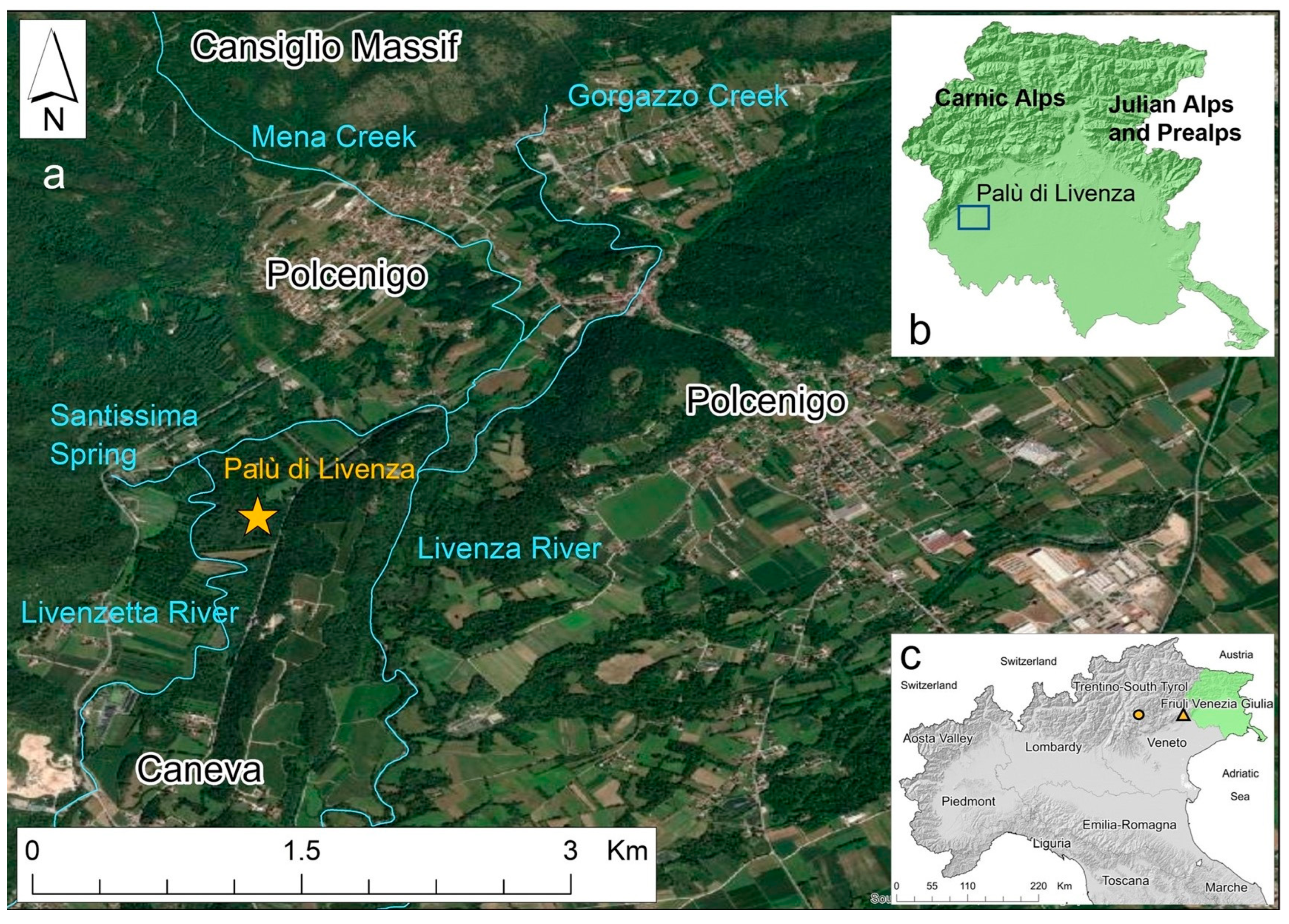
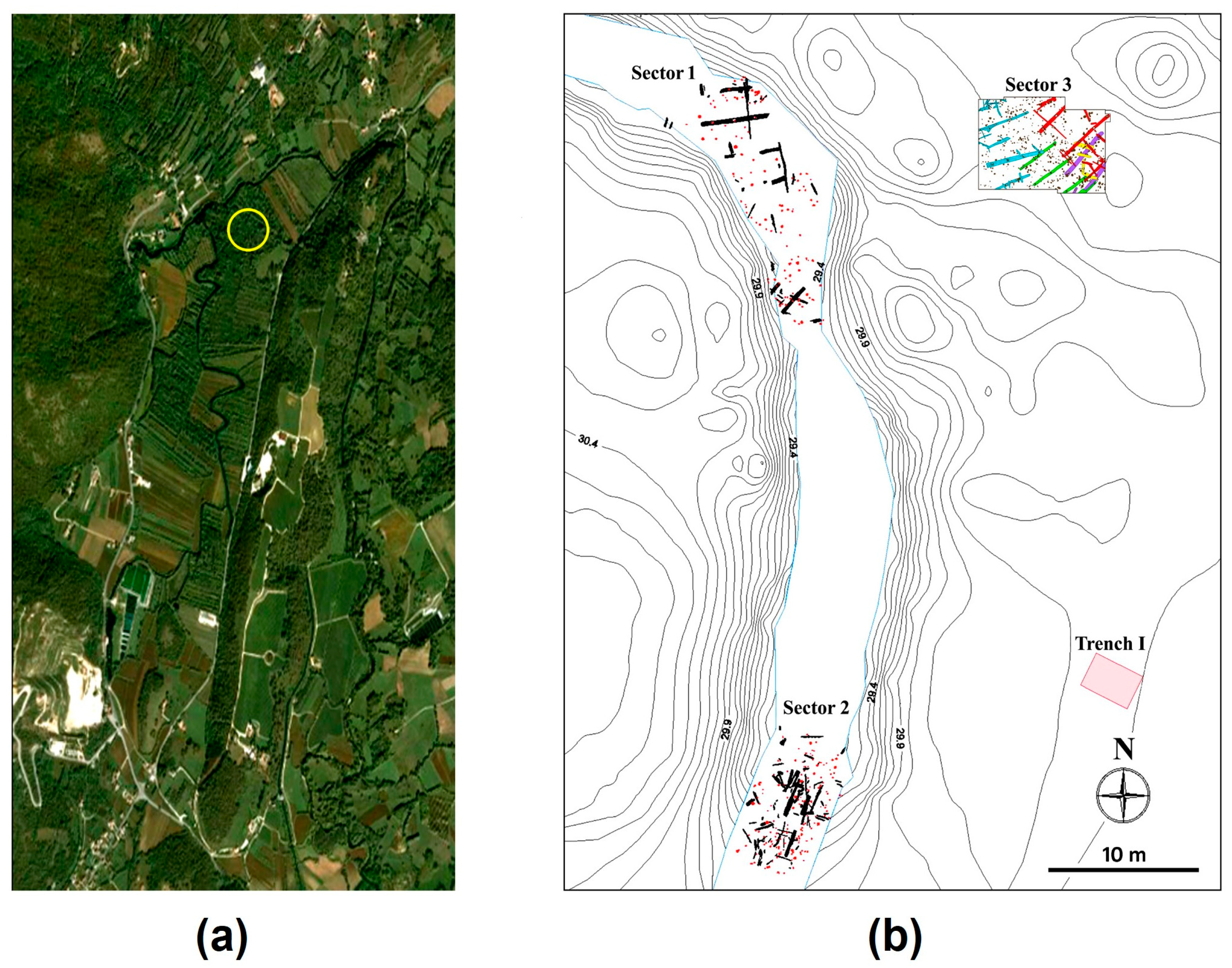
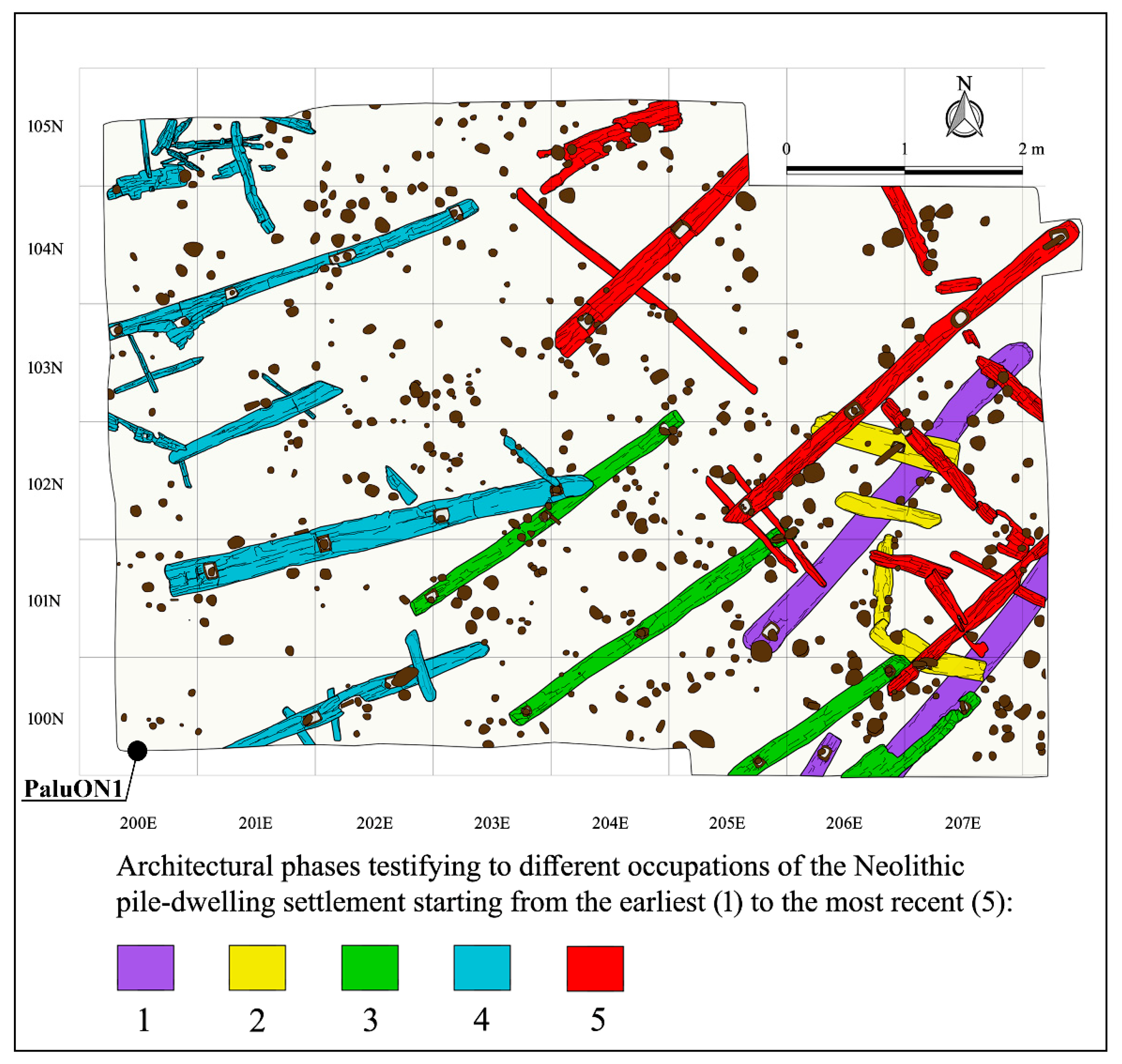
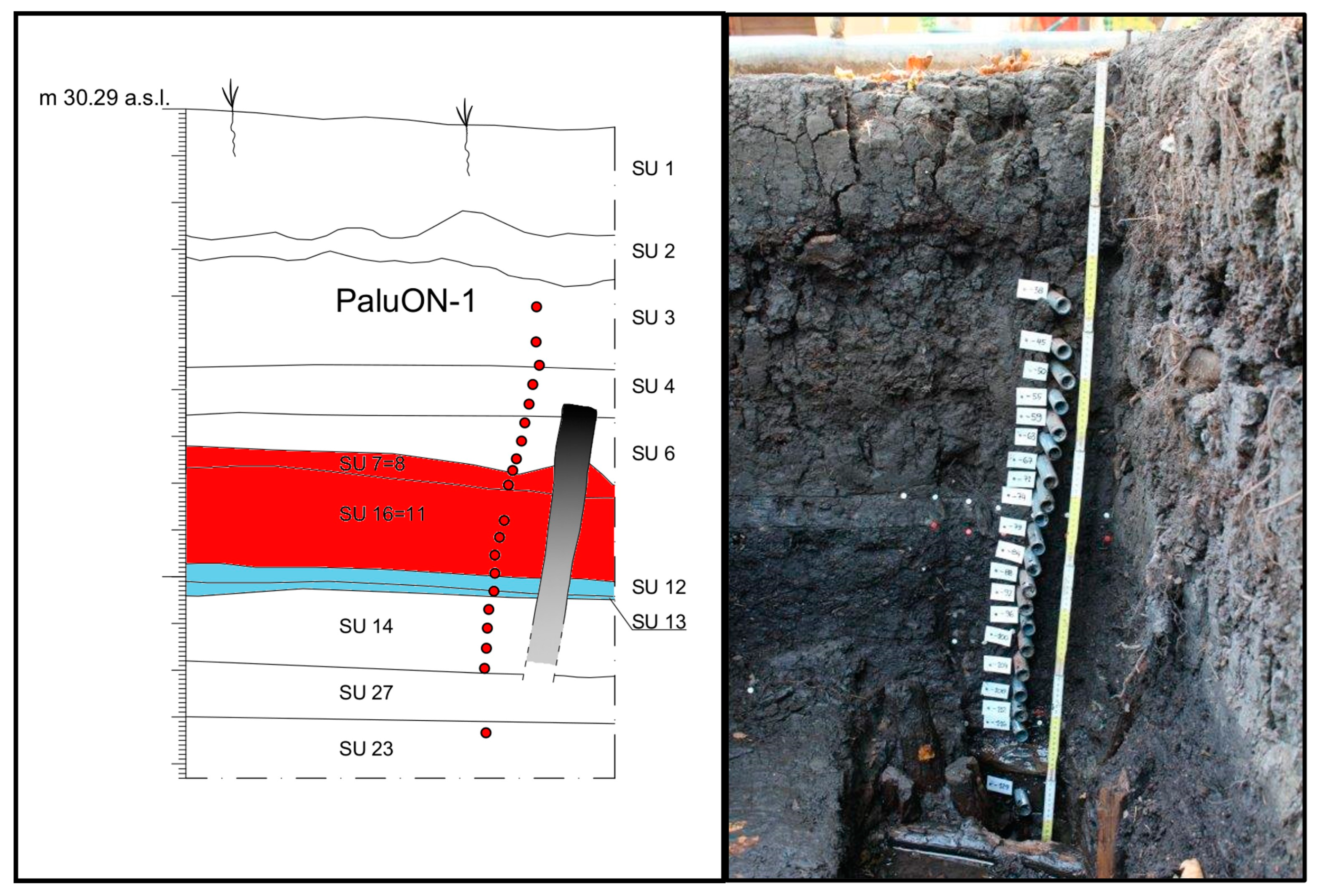
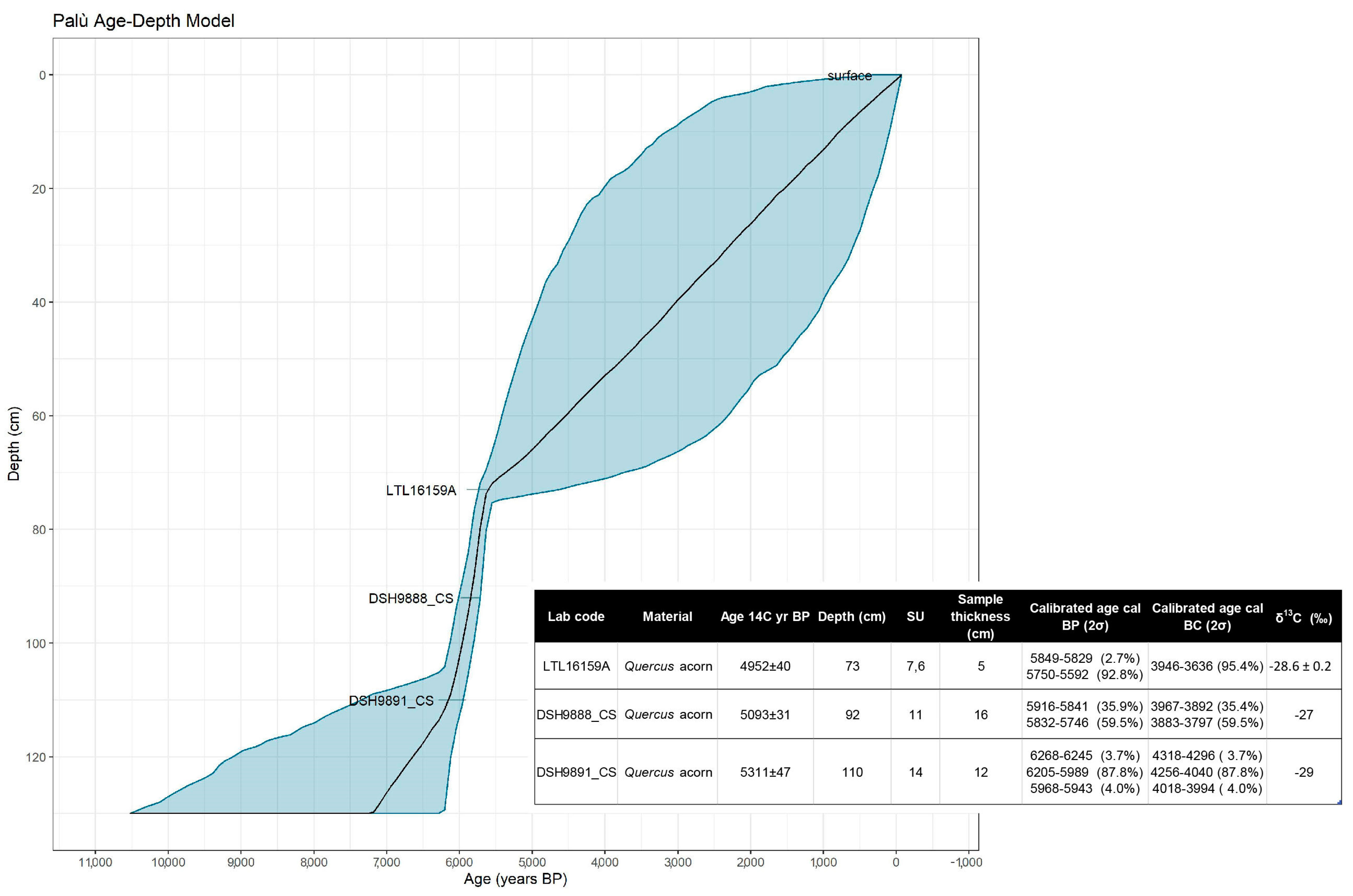
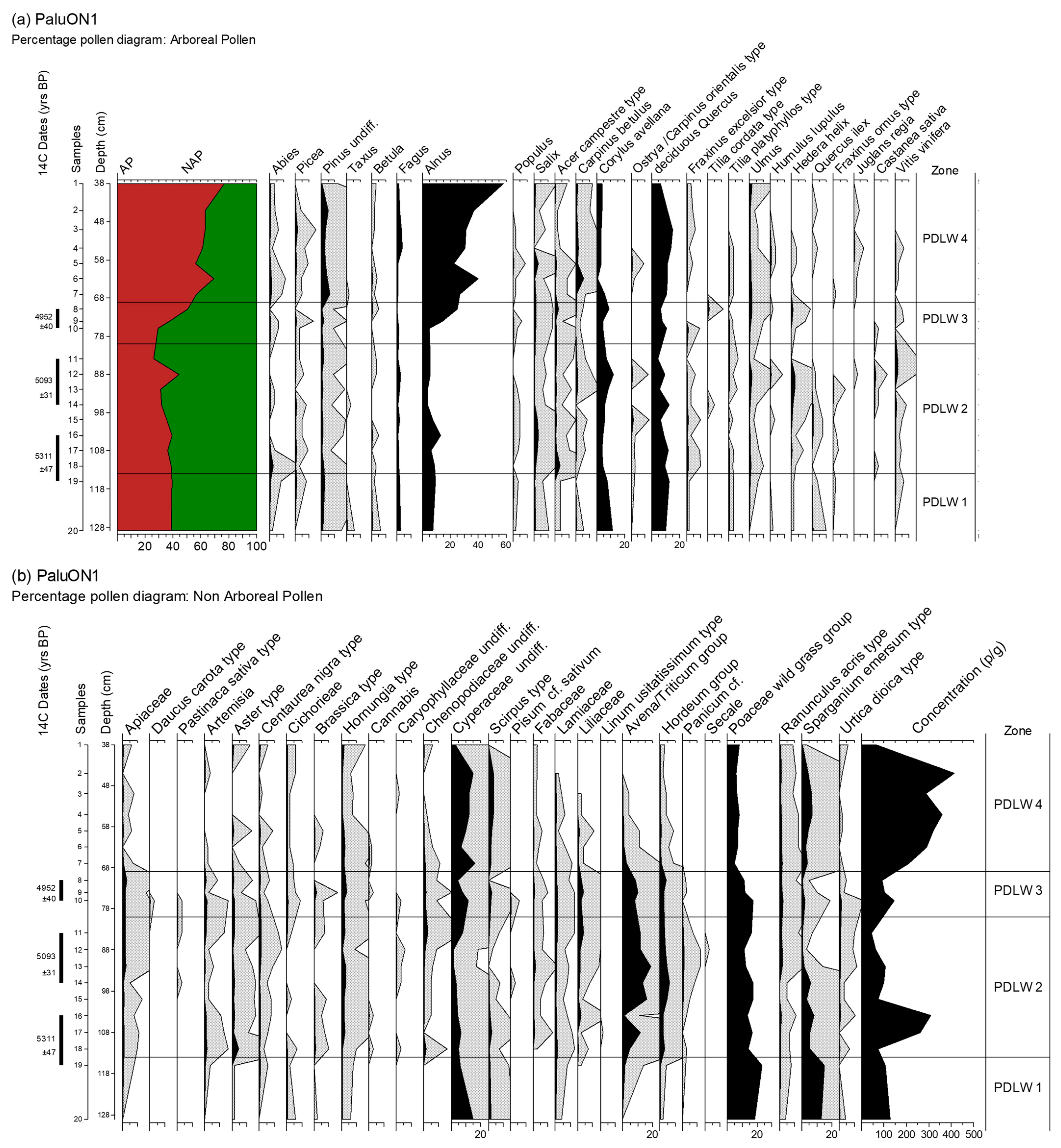

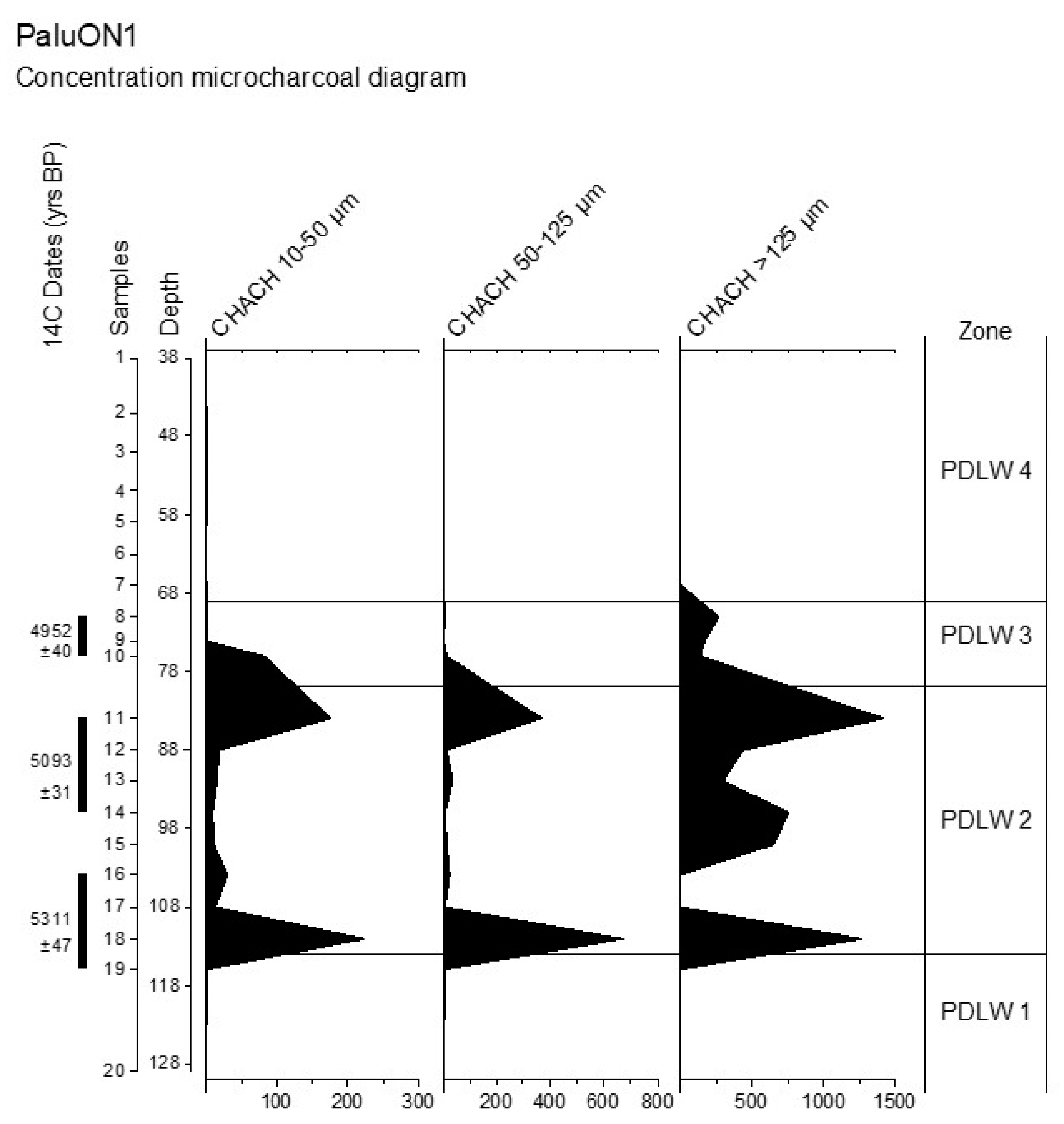
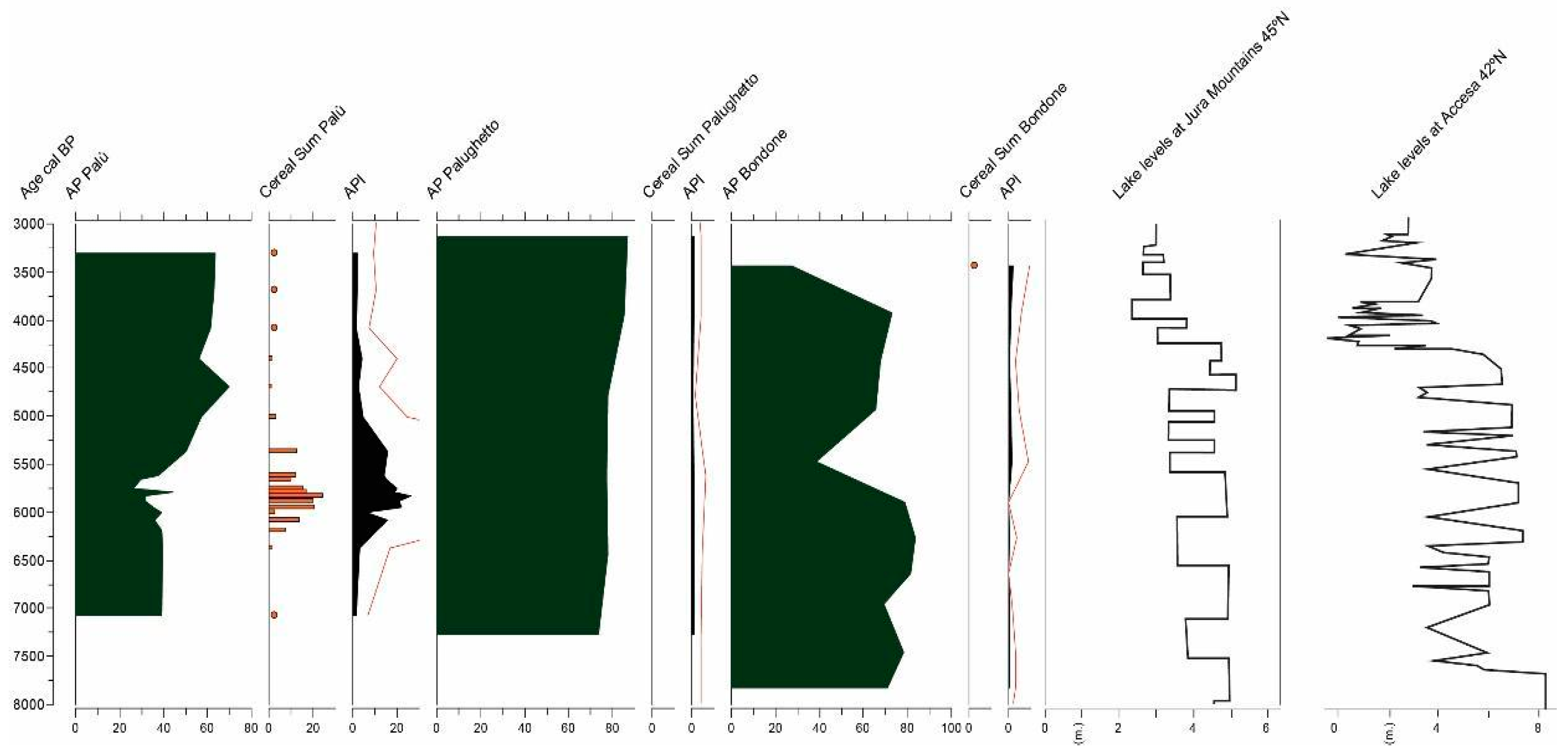
| Sample | Depth (cm) | SU | Phase |
|---|---|---|---|
| 1 2 3 | 38 45 50 | 3 | Wooden swamp/Peat Bog |
| 4 5 | 55 59 | 4 | Wooden swamp |
| 6 7 8 | 63 67 71 | 6 | Mud deposit/high water level |
| 9 10 | 74 76 | 7 | Archaeological phase 5b |
| 11 12 13 14 | 84 88 92 96 | 11 | Archaeological phase 5a |
| 15 | 100 | 13/12 | Archaeological phase 4 |
| 16 17 18 19 | 104 108 112 116 | 14 14 bottom | Archaeological phase 3 |
| 20 | 129 | 23 | Pre-settlement |
Disclaimer/Publisher’s Note: The statements, opinions and data contained in all publications are solely those of the individual author(s) and contributor(s) and not of MDPI and/or the editor(s). MDPI and/or the editor(s) disclaim responsibility for any injury to people or property resulting from any ideas, methods, instructions or products referred to in the content. |
© 2023 by the authors. Licensee MDPI, Basel, Switzerland. This article is an open access article distributed under the terms and conditions of the Creative Commons Attribution (CC BY) license (https://creativecommons.org/licenses/by/4.0/).
Share and Cite
Zappa, J.; Degasperi, N.; Bassetti, M.; Florenzano, A.; Torri, P.; Servera-Vives, G.; Mercuri, A.M.; Micheli, R. Plants, Fire and Landscape at the Prehistoric Pile-Dwelling Village of Palù di Livenza (PaluON1), UNESCO Site in the Italian Alps. Quaternary 2023, 6, 34. https://doi.org/10.3390/quat6020034
Zappa J, Degasperi N, Bassetti M, Florenzano A, Torri P, Servera-Vives G, Mercuri AM, Micheli R. Plants, Fire and Landscape at the Prehistoric Pile-Dwelling Village of Palù di Livenza (PaluON1), UNESCO Site in the Italian Alps. Quaternary. 2023; 6(2):34. https://doi.org/10.3390/quat6020034
Chicago/Turabian StyleZappa, Jessica, Nicola Degasperi, Michele Bassetti, Assunta Florenzano, Paola Torri, Gabriel Servera-Vives, Anna Maria Mercuri, and Roberto Micheli. 2023. "Plants, Fire and Landscape at the Prehistoric Pile-Dwelling Village of Palù di Livenza (PaluON1), UNESCO Site in the Italian Alps" Quaternary 6, no. 2: 34. https://doi.org/10.3390/quat6020034
APA StyleZappa, J., Degasperi, N., Bassetti, M., Florenzano, A., Torri, P., Servera-Vives, G., Mercuri, A. M., & Micheli, R. (2023). Plants, Fire and Landscape at the Prehistoric Pile-Dwelling Village of Palù di Livenza (PaluON1), UNESCO Site in the Italian Alps. Quaternary, 6(2), 34. https://doi.org/10.3390/quat6020034










